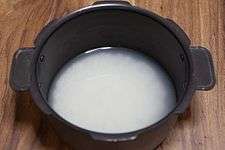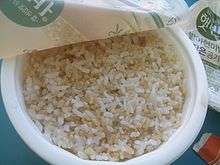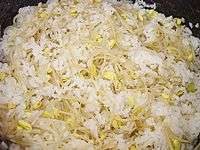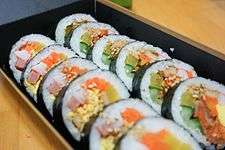Bap (food)
.jpg) | |
| Place of origin | Korea |
|---|---|
| Main ingredients | Rice and/or other grains |
| 85 kcal (356 kJ)[1] | |
|
| |
| Korean name | |
| Hangul | 밥 |
|---|---|
| Revised Romanization | bap |
| McCune–Reischauer | pap |
| IPA | [pap̚] |
 |
| This article is part of a series on |
| Korean cuisine 한국 요리 조선 료리 |
|---|
|
Staples |
|
|
In Korean cuisine, bap (밥), often translated as "rice" or "cooked rice",[2][3] is a dish prepared by boiling rice and/or other grains, such as black rice, barley, sorghum, various millets, and beans, until the water has cooked away.[4][5] Special ingredients such as vegetables, seafood, and meat can also be added to create different kinds of bap.[6] There are many bap dishes such as bibimbap (비빔밥, "mixed rice"), bokkeum-bap (볶음밥, "fried rice") and gimbap (김밥, "seaweed rice").
The word can also be used to refer to a meal. The honorific forms of bap (meal) include jinji (진지) for an elderly, sura (수라) for the monarch, and me (메) for the deceased (in the ancestral rites).
Preparation
Traditionally, bap was made using gamasot (a cast iron cauldron) for a large family, however in modern times an electronic rice cooker is usually used to cook rice. Regular heavy-bottomed pot or dolsot (stone pot) can also be used. Nowadays, rice cooked in gamasot or dolsot are called sotbap, and are considered as delicacies. More nurungji (scorched rice) is produced when making gamasot-bap (cast iron cauldron rice) and dolsot-bap (stone pot rice).
To make bap, rice is scrubbed in water and rinsed several times. This process produces tteumul (water from the last washing of rice).[7] It is then soaked for thirty minutes before boiling, which helps the grains cook evenly. With unpolished brown rice and bigger grains such as Job's tears, it is necessary to soak the grains for several hours to overnight to avoid under-cooking. The grains are then cooked. In a regular heavy bottomed pot, rice can be cooked over medium high heat with the lid on for about ten minutes, stirred, and then left to simmer on low heat for additional five to ten minutes.
The scorched rice in the bottom of the pot or cauldron, nurungji, can be eaten as snacks or used to make sungnyung (an infusion made from boiling scorched rice).
 stone pot rice
stone pot rice tteumul
tteumul.jpg) boiled scorched rice
boiled scorched rice
Types
Ingredients
Rice
The most basic bap made of rice is called ssalbap (쌀밥, "rice bap"), or often just bap. As rice itself occurs in colours other than white, the bap made of all white rice is called huinssal-bap (흰쌀밥, "white rice bap") or ssalbap. When black rice is mixed, it is called heungmi-bap (흑미밥, "black rice bap").
When cooked with all brown rice (unpolished rice) or white rice mixed with brown rice, it is called hyeonmi-bap (현미밥, "brown rice bap"), while bap cooked with all glutinous rice or white rice mixed with glutinous rice is called chapssal-bap (찹쌀밥, "glutinous rice bap"). Unpolished glutinous rice can also be used to cook bap, in which case it is called hyeonmi-chapssal-bap (현미찹쌀밥, "brown glutinous rice bap").
Bap made of regular non-glutinous white rice (polished rice) can be referred to as baekmi-bap (백미밥, "white rice bap") when compared to hyeonmibap, and as mepssal-bap (멥쌀밥, "non-glutinous rice bap") when compared to chalbap/chapssalbap.
_2.jpg) white rice
white rice.jpg) black rice
black rice instant brown rice
instant brown rice
Rice and/or other grains
Bap made of rice mixed with various other grains is called japgok-bap (잡곡밥, "multi-grain rice"). On the day of Daeboreum, the first full moon of the year, Koreans eat ogok-bap (오곡밥, "five-grain rice") made of glutinous rice, proso millet, sorghum, black beans, and red bean, or chalbap (찰밥, "sticky rice") made of glutinous rice, red bean, chestnut, jujube, and black beans.
When rice is mixed with one other grain, the bap is named after the mixed ingredient. The examples are:
Some grains can be cooked without rice. Bap made of barley without rice is called kkong-bori-bap (꽁보리밥), while bap made of both rice and barley is called bori-bap (보리밥).
.jpg) multi-grain rice
multi-grain rice.jpg) cooked barley
cooked barley
Special ingredients
Byeolmi-bap (별미밥, "special delicacy rice") or byeolbap (별밥, "special rice") can be made by mixing in special ingredients such as vegetables, seafood, and meat.[8] For example, namul-bap (나물밥, "namul rice") is made of rice mixed with namul vegetables.[9] Some popular byeolmibap varieties include:
- bambap (밤밥, "chestnut rice")
- biji-bap (비지밥, "tofu dreg rice")
- gamja-bap (감자밥, "potato rice")
- gondeure-bap (곤드레밥, "gondre rice")
- gulbap (굴밥, "oyster rice")
- gyeran-bap (계란밥, "egg rice")
- jogae-bap (조개밥, "clam rice")
- kongnamul-bap (콩나물밥, "soybean sprout rice")
- mubap (무밥, "radish rice")
- songi-bap (송이밥, "pine mushroom rice")
- ssukbap (쑥밥, "mugwort rice")
_(Cirsium_setidens)_Korean_thistle.jpg) gondre rice
gondre rice.jpg) oyster rice
oyster rice soybean sprout rice
soybean sprout rice
Bap dishes
- bibimbap (비빔밥, "mixed rice") – rice topped with seasoned vegetables, meat, mushrooms, eggs, seasonings, and other additives. All the ingredients are stirred before eating
- bokkeum-bap (밥, "fried rice") – rice stir-fried with chopped vegetables or meat in oil
- deopbap (덮밥, "topped rice") – cooked rice topped with something that can be served as a side dish (e.g. Hoedeopbap is topped with hoe.)
- gimbap (김밥, "seaweed rice") – a dish made by rolling rice and various other ingredients in gim (edible laver) and cutting them into bite-size slices
- gukbap (국밥, "soup rice") – cooked rice put into or boiled in a hot soup
- heotjesatbap (헛제삿밥, "pseudo-jesa rice") – a bimbimbap-like dish served with vegetables traditionally used in ancestral rites
- jumeok-bap (주먹밥, "rice ball") – cooked rice made into balls
- ssambap (쌈밥, "rice wraps") – cooked rice along with several side dishes and ssamjang on a leaf of lettuce, perilla, etc.
- yakbap (약밥, "sweet rice") – steamed glutinous rice mixed with honey, jujubes, soy sauce, sesame oil, chestnuts, pine nuts, etc.
 bibimbap
bibimbap gimbap
gimbap yakbap
yakbap
See also
References
- ↑ "huinbap" 흰밥. Korean Food Foundation (in Korean). Retrieved 16 May 2017.
- ↑ Lee, Cecilia Hae-Jin (5 January 2015). "Six Koreatown restaurants with great banchan". Los Angeles Times. Retrieved 28 February 2017.
- ↑ Korea Tourism Organization (21 February 2017). "Exploring Korea’s true flavor". Stripes Korea. Retrieved 28 February 2017.
- ↑ "밥" [bap]. Basic Korean Dictionary. National Institute of Korean Language. Retrieved 8 January 2017.
- ↑ An Illustrated Guide to Korean Culture - 233 traditional key words. Seoul: Hakgojae Publishing Co. 2002. pp. 12–13. ISBN 978-89-85846-98-1.
- ↑ "Types of Korean Food – Staple food". www.hansik.org. Korean Food Foundation. Retrieved 8 January 2017.
- ↑ "Rice Water Bright Cleansing Light Oil". international.thefaceshop.com. The Face Shop. Retrieved 8 January 2017.
- ↑ "별밥" [byeolbap]. Standard Korean Dictionary (in Korean). National Institute of Korean Language. Retrieved 8 January 2017.
- ↑ "나물밥" [namulbap]. Standard Korean Dictionary (in Korean). National Institute of Korean Language. Retrieved 8 January 2017.